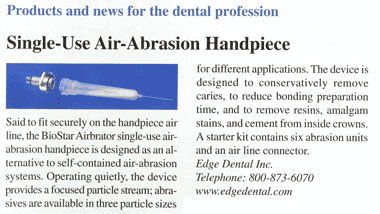Forums › Other Lasers › Misc. Laser Forum › Diagnodent readings and tx
- This topic is empty.
-
AuthorPosts
-
AnonymousGuestHi All,
Just read a case study today about teeth number 20-29 being restored with an er:YAG laser.
Below are the Diagnodent readings for these ‘Attrition Caries’
29 4
28 5
27 3
26 7
25 9
24 3
23 0
22 1
21 2
20 3
The article states ‘The er:YAG laser provides excellent caries removal and excellent tooth preparation for bonding without the need for anesthetics.’Would you attribute those numbers to ‘caries’ ?
If there wasn’t attrition involved -would you restore those teeth , with those diagnodent readings?
Glenn van AsSpectatorTerrible treatment………..bogus.
I treat usually above 20-25 and its because I am conservative.
This is crazy.
Glenn
PatricioSpectatorI like to start with a number around forty or higher and then work down to lower numbers depending upon the decay I find at the higher number and the over all patient’s decay profile. I often double check with my unit what the hygienist found and to locate for myself the exact location of the defect before I start.
Pat
greg holmSpectatorI agree. I usually don’t treat anything below a 40 unless there is a real caries problem in a pt. But, I certainly can’t think of a single tooth I have ever tx that had a reading of less than 10.
Greg
joesimmonsddsSpectatorCertainly seems like a case of overtreatment. Like Pat, I will verify hygienist’s readings with my unit prior to commencing treatment and will only restore where those are >20. I have never NOT seen caries in teeth with readings above 20. Although, I’ve gone in to do several sealants (DIAGNOdent readings between 15-20) only to find significant decay deeper in the tooth (usually mandibular premolars) than normally seen.
2thlaserSpectatorRon, where did you read about that case? Just curious. Because I think I just read a similar review. Just wondering.
Mark
AnonymousGuestMark, I sent you a PM. I don’t want to draw negative attention to the doc or the organization that published the article, so I won’t post that here.
jetsfanSpectatorjust curious,
do you guys an gals use the kavo polisher or prophy jet or some other particulate stain remover( other than pumice or prophy paste) before taking readings. I find that the maintenece, after each use, of Kavo’s unit is so cumbersome that my hygienists do not want to use it.
Jetsfan
PatricioSpectatorJetsfan,
I find the explorer to be effective. I do my best to remove all plaque materials from the groves and pits before using the Diagnodent and I never use any polishing materials. I have adjusted my numbers to provide nearly 100 percent positives when I restore so what I do works for me. Our hygienist may polish first and will often have used the various automatic aids like a prophy jet and if the lesion is not obvious I double check it with my machine.
Pat
greg holmSpectatorFirst post for me in a while. We use a prophy jet and used to also use a disposable aa called airbrator to clean out grooves. we still use prophy jet but Graeme Millich who has a great cd on diagnodent told me the aa would remove too much tooth structure as well so we no longer do this.
Greg
AnonymousGuestGreg, Graemes cd’s are terrific.
Is this the airbrator you’re talking about?

At บ -พ do you follow the single use?Easy to connect/disconnect? Mess?
Thanks
greg holmSpectatorRon. No we don’t. We have found that we can refill these ourselves with powder. The tubes or tips are wiped off between pts. these tips do wear out though and then we replace by purchasing new. These things do work. I mainly use them for cleaning out my preps. I have one set up in each op.
Greg
greg holmSpectatorBy the way the hose adapter(the metal coupler at the left in the pic) is about ๑? to get started too. But, I do
like these things. They work every bit as well as the Mach 4 I paid บK for in 95! I have since thrown the Mach 4 into the dumpster literally!
Greg
PatricioSpectatorGreg,
What do you mean, “cleaning out your preps”?Pat
greg holmSpectatorPat. There is a major difference in the ‘look’ of the prep after ‘cleaned’ by aa. The ‘schmutz’ or I suppose the smear layer is visibly ‘cleaned of any residue or debris which will be apparent after aa use. They look pristine. I probably would not do a fill or cr prep now without aa ‘cleansing’, the difference is that obvious. I have no scientific data, just personal observation.
Greg -
AuthorPosts
